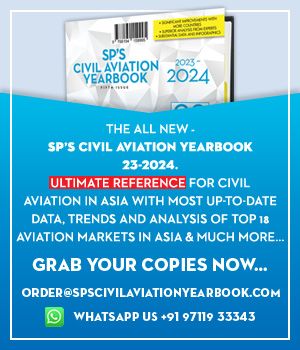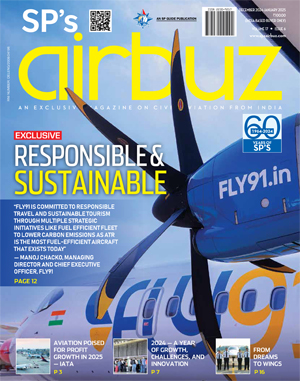Paris Air Show - Windfall at Paris

Air Asia grabbed headlines by ordering 200 A320neo for $18.2 billion ( Rs. 81,900 crore) and Airbus, with a record 730 orders at the Paris Air Show, was laughing all the way to the bank. Le Bourget too, like other air shows, endorsed that increased business would come from the emerging markets, particularly Asia.
Notwithstanding the inclement weather, the 49th International Paris Air Show at Le Bourget came up trumps and was indicative of recovery in the aerospace industry. The 49th show had 2,113 exhibitors from 45 countries with a record number of visitors—3,45,000 of which 1,45,000 were trade visitors. Summing up, the Commissaire General of the International Paris Air Show, Louis Le Portz said, “It was an outstanding showcase for new technologies and was a clear sign of recovery for the aerospace industry.”
“With the public unveiling of the show’s special guest, the Solar Impulse solar aircraft, flying displays by the Eurocopter X3 helicopter, the Airbus A380 and the Dassault Aviation Rafale, and the presence of Airbus Military’s A400M and the Boeing 747-800 and 787, this year’s event was a showcase of the extraordinary advances in technology achieved by the aerospace industry.”
It rained aeroplanes and some of the emerging Asian tigers picked planes as if they were at a sale.
Air Asia grabbed headlines by ordering 200 A320neo for $18.2 billion ( Rs. 81,900 crore) and Airbus with record 730 orders at the Paris Air Show was laughing all the way to the bank. Le Bourget too, like other air shows, endorsed that increased business would come from the emerging markets, particularly Asia. The Chief Executive Officer of Air Asia, Tony Fernandes, said, “Our first aircraft deal was at this same Paris Air Show in March 2005. In six years, we have ordered 375 planes and 35 for Air Asia X. It has been a remarkable growth in such a short period of time.”
The record orders for Airbus—730 aircraft valued at $72.2 billion ( Rs. 3,24,900 crore), most of it picked up by A320neo (new engine options) that offers nearly 15 per cent fuel efficiency, reflected the requirements of the industry. The Brazilian aerospace behemoth Embraer, the world’s fourth largest commercial airplane manufacturer, also bagged 39 orders for its E-Jet series of regional aircraft, worth $1.7 billion ( Rs. 7,650 crore).
Meanwhile, Boeing announced that it would continue its work on accelerating quieter, cleaner aviation technologies. Reducing fuel consumption, carbon emissions and community noise would remain its strategy. Boeing Commercial Airplanes President and CEO Jim Albaugh said, “Airlines today worry about their environmental footprint, fuel efficiency and sustained profitability. Our family of ultra-efficient products directly support these customer needs.”
The tone for the green refrain was set by the French President Nicolas Sarkozy who said, “Solar Impulse is a reminder that we must think of more energy efficient aircraft solutions right away. Shaping the future of aviation also means creating sustainable aircraft.” The Solar Impulse innovation demonstrated that clean technology can reduce our dependence on fossil fuels which are not just prohibitive in cost but also have adverse environmental impact.
Boeing also went to town announcing that American Airlines would be its launch customer for the evolutionary ecoDemonstrator programme. Boeing is finalising plans for installing the initial technology applications aboard the first airplane with specific technologies that will be flown in 2012. The programme is working towards reducing noise and emissions during all phases of flight including take-off, cruise and landing.
One of the highlights of the show was the arrival of the Boeing 747-8 Freighter after completing its first transatlantic flight with four General Electric GEnx-2B engines powered by a blend of 15 per cent camelina-based biofuel mixed with 85 per cent traditional kerosene Jet A fuel.
Not just these two companies, several others showcased their ‘green’ capabilities— ATR proudly announced that it is the first green-certified regional aircraft manufacturer for the lifecycle of its planes; Pratt & Whitney put on display its family of PurePower engines; Air France Industries-KLM Engineering & Maintenance explained how Ecoshine technique on an average used eight cubic metre of water less per aircraft washed; CleanSky held round tables to further its ambitious aeronautical research programme ever launched in Europe—to develop breakthrough technologies to significantly increase the environmental performances of airplanes and air transport, among others.
Some of the highlights of the show included the Boeing 787 and Intercontinental 747-8 passenger and freighter models, making their first appearances here. On the military side, AgustaWestland showcased its new AW149 twin helicopter.
However, while weapon systems were on display, there was no new combat jet on display. It was for the in-service fighter jets—Dassault Aviation’s Rafale; Eurofighter Typhoon; and Lockheed Martin’s F-16 to add to the supersonic boom. Airbus Military’s A400M and the innovative Eurocopter X3 helicopter did grab eyeballs.
Defence majors exhibited weapons and sub-systems and had taken substantial exhibition space—Finmeccanica, Lockheed Martin, Northrop Grumman, BAE Systems, Safran, Thales, etc. As per show statistics, 17 per cent of the trade visitors, the largest group, constituted airborne systems (including weapons). Russian airframer Irkut also launched the MC 21 aircraft with new avionics from Rockwell Collins.





